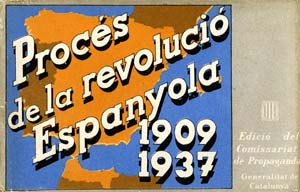Revolution in Spain
Procés de la revolució Espanyola 1909-1937
Edició del Comissariat de Propaganda
Generalitat de Catalunya
Series of 12

The Spanish Civil War erupted as the culmination of problems brewing within Spain for decades. A common literary trope of the era was the development of the "two Spains" argument. Using this device, contemporaries separated the country into two oppositional groups. On one side, it was argued stood the wealthy classes, the Church, the military, and Spanish nationalists. On the other side, the working classes, atheists, and ethnic nationalists, were seen to pose a threatening counterpoint to the established order. Growing conflict between these two groups was seen to be at the heart of Spanish troubles during the early part of the twentieth century.
The twelve postcards in this set complete a step by step chronology of events leading up to and pertaining to the war itself. Given the portrayal of events, the postcards in this collection present a biased view of several major events in the history of modern Spain seen from the perspective of the left to be major stepping stones toward the state of affairs in mid-1937. To use the overly simplistic model of the "two Spains" metaphor, this narrative of events places blame for the Civil War squarely on the shoulders of one Spain while portraying the other as victim.
Published by the propaganda office of the regional government of Catalonia (Generalitat de Catalunya), this set was one of several forms of targeted media used during the war for propaganda purposes. During the war, the Generalitat de Catalunya, under the leadership of Lluís Companys and the Esquerra Republicana, exercised a strong display of autonomy from the central government. This state of affairs allowed for the cultivation of a strong regional propaganda apparatus that functioned amidst a flurry of material produced by the other major political parties, trade unions, and other groups.
Postcards of this sort were meant to educate outsiders on the predicament of the Republican government. For those familiar with the then recent historical event, this chronology represented one interpretation, for some perhaps a reinterpretation, of Spanish history. As such, it presented a highly persuasive case for supporting the Republican government as the more legitimate and representative government of the two belligerent parties.
NOTE: The captions below were taken form the postcards themselves. At the top of each section, the Catalan text appears in bold. Successive lines list alternate Spanish, French, English, and Esperanto translations taken from the reverse side. The varied ordering of languages follows their placement on the original.












